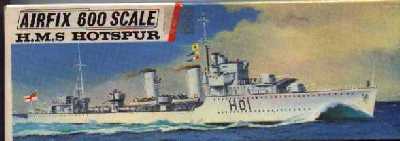
Airfix 1/600 Scale HMS Hotspur
Review by Robert Brown
This kit was first released in 1964, and according to my research
went out of production in 1983. It remains highly sought after due to the
fact that the basic hull and superstructure can be used to make any of
the British Standard Destroyers of the 1930’s. These 89 ships built to
the same basic design include the first 2 prototypes, the 8 ½ flotillas
of the A-I classes, the ex-Brazilian ‘H’ class and the ex-Turkish ‘I’ class.
These ships made up the bulk of the RN and RCN destroyer strength in the
early years of World War II. Their war records are magnificent, but losses
were heavy, 54 being sunk or damaged beyond repair. This kit represents
the as-built configuration of the ‘H’ class.
The kit consists of 72 parts, including the 2 stands. The hull comes
in 2 pieces, with a single piece main deck. As with all Airfix warship
releases, it comes as a full hull kit complete with propellers and rudder.
It can be easily cut down to a waterline version, although it lacks the
internal cut line that is found on the later Airfix releases, such as HMS
Belfast and the German Narvik. It scales out at 316 ft, 7 ft shorter than
its real length, not a significant difference.
Due to its age, this kit suffers in comparison with the latest
state of the art. Not much in the way of molded in detail, no hatches or
deck detail, the ship’s boats are crude, no superstructure details with
the exception of a separate bridge front that has some portholes, and some
smaller parts that are just blobs of plastic. There are some unfortunate
mold ejection pin markings (those little round circles) present that will
have to be filled, especially on the ship’s boats. The gun mounts are somewhat
crude, but are passable. The masts are also too thick, a common problem
with these older kits.
What detail is present though is nice and crisp, the hull is nicely
shaped with good portholes, reasonable anchor chains, very nice torpedo
tubes, torpedo loading davits, and TSDS davits (Twin-Speed Destroyer Sweep).
My sample, one of the early releases, is molded in neutral grey and has
nice crisp parts with very little flash. I have seen later kits that are
not as sharp, most likely due to the molds becoming old.
Instructions are good, consisting of 2 pages of exploded diagrams showing
where the parts go. The older kits have detailed step-by-step assembly
instructions telling what the parts are, very helpful for identifying some
of the more ill formed pieces. Experienced modelers would probably ignore
the order of assembly, but for newcomers they are adequate. A profile and
plan are supplied showing painting instructions, although the use of ‘Battleship
Grey’ for the main hull colour would certainly raise eyebrows amongst those
committed to accurate paint schemes! Decals consist of one small sheet
with 3 hull numbers for HMS Hotspur.
This kit is hard to come by, although they appear regularly on
eBay (look to pay around $15-20 US for a nice one). I don’t imagine Airfix
will be re-releasing this one soon, as it pales in comparison with the
newer destroyer kits.
Still, I really like and recommend this kit. It is simple to build,
looks fairly sharp right out of the box, and it’s very evocative of those
dark early days in World War II when these destroyers carried the fight
to the enemy. The conversion possibilities are also enormous. Of course,
the detailing possibilities are endless, but add some brass rail and replace
the masts with brass rod, and you will have a very sharp model.
As far as conversions go, these ships fought all over the world and
appeared in many different forms, from minelayer to long range ocean escort
to fleet destroyer. There were a number of articles in Airfix magazine
that detailed how to go about changing the basic kit. Try to find some
of these, they are very helpful.
There are many detail differences between the 89 ships. The prototypes
Amazon and Ambuscade were slightly different in funnel and bridge details.
The ‘G’ class HMS Glowworm and all the ‘I’ class had quintuple torpedo
tubes. Hero and Hereward, the ‘I’ class, and the ex-Brazilian and Turkish
ships had a Tribal style bridge. Most of the leaders had an extra 4.7 inch
mount between the funnels. The G, H and I’s had tripod mainmasts.
The kits’ basic hull dimensions are correct for either of the
2 prototypes, the ‘A’, ‘B’, ‘G’, ‘H’, ‘I’ classes, Brazilian ‘H’, Turkish
‘I’, RCN Saguenay and Skeena, and the B leader Keith.
Although the other ships can also be modeled fairly accurately
from the basic kit, here are the actual hull sizes of the differing ships.
The ‘C’, ‘D’, ‘E’, ‘F’ classes, C leader Assiniboine, and D leader Duncan
were all 329 ft. The G leader Grenville was 330 ft overall. The H and I
leaders Hardy and Inglefield were 337 ft long. The A, E, and F leaders
Codrington, Exmouth, and Faulknor were all 343 ft in length.
Click on thumbnail for a full-size picture
|